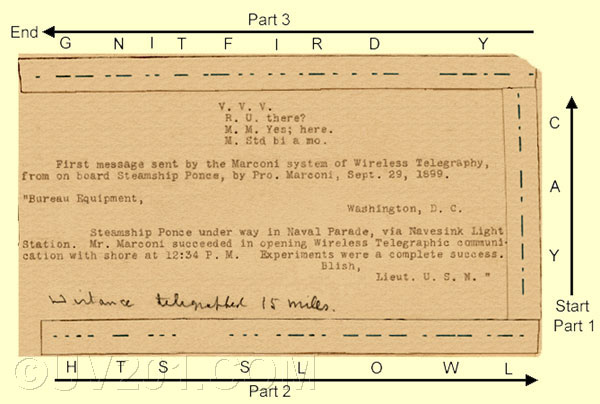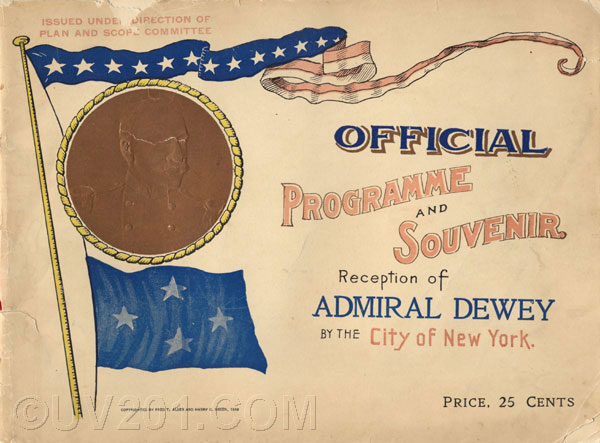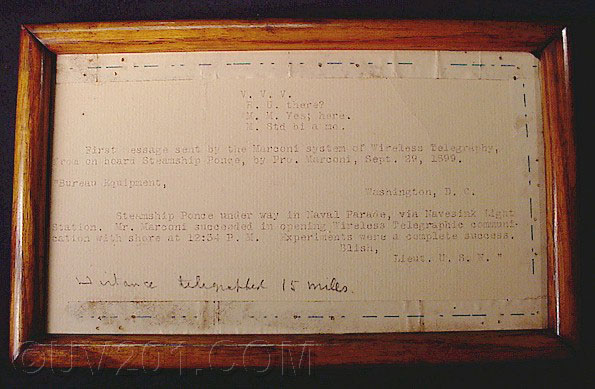|
1899 Marconi Radio Message |
||
|
In late 1899, Guglielmo Marconi was invited (and paid) by the New York Herald newspaper to use his fledgling wireless system to report on the progress of that year's Americas Cup yacht races, which were to be held off the coast of New Jersey. He accepted, eager for any opportunity to promote his system. The U.S. Navy was very interested in the new technology and made arrangements to observe these operations, and conduct tests of their own. By chance, coinciding with the planned start of the races, Adm. George Dewey's flagship, the USS Olympia, was returning to the US after his victory at Manila Bay. In his honor, the City of New York planned three days of celebrations which began on September 28, 1899. On the first day, a triumphant naval parade sailed north through the Lower New York Bay, and anchored at government facilities off Tompkinsville (on Staten Island). On the second day, the parade continued up the Hudson river, where the Olympia anchored opposite Grant's Tomb (at W. 122 Street in Manhattan). The remainder of the parade passed the Olympia in review, and then reversed course and sailed south. The third day was devoted to parades and celebrations on land for the officers and crew of the Olympia. The events of each day were capped by massive fireworks displays, and decorative displays of electric lighting, which was an exciting novelty at that time. The naval parade included the Olympia and several other naval vessels. The two yachts that were to participate in the races were also invited to participate (Sir Thomas Lipton's Shamrock, and J. P. Morgan's Columbia II), as well as a flotilla of merchant marine vessels and other private yachts. Marconi set up his equipment on the S.S. Ponce, and several other vessels. Shore stations were located in the lighthouse at Navesink, NJ, and in a building in Manhattan. On September 28, the following message was sent from the Ponce to the Navesink shore station. It is considered to be the first official US Naval radio message, and was also the first paid ship-to-shore radiogram:
Lt. John Blish was one of the observers assigned by the Navy to report on the Marconi demonstrations. The actual Americas Cup races were held from about Oct. 3 through Oct. 20, 1899. The weather was not cooperative, and there was little wind throughout most of this period. Marconi and his crew transmitted numerous progress reports on these "drifting contests" to shore. It was a great media event. Interest in the race, itself, was high, and the new technology was big news as well. The pictured artifact was originally found in a small oak frame. The messages were typed on a piece of heavy paper which was trimmed to fit the frame. To this, along three edges, were glued strips of paper showing patterns of Morse Code dots and dashes in blue ink. These strips are about 1/2 inch wide. There is also a penciled inscription "Distance Telegraphed 15 Miles". It is known that Marconi used telegraph registers to record incoming traffic during these operations. Such devices used the signals to cause an ink-saturated felt wheel to contact a moving strip of paper to provide a printed record of the message. Clearly, these strips were printed by a telegraph register. Close examination of the strips makes it clear that they were originally one piece. There are pencil marks on the tapes which document someone's long-ago effort to read the message. The glue that was used has caused a number of brown spots to appear. It is clear that whoever sent this message was not a skilled telegrapher, as the length of the dots and dashes and inter-character gaps are not constant. The primitive equipment may account for this, though a contemporary account quotes Marconi as having mentioned his own difficulty in remembering the code. Perhaps Marconi, himself, sent this message. The only interpretation of this message that makes sense has it reading "YACHTS SLOWLY DRIFTING". This, then, must be some of the reporting from the races. The mention of drifting is consistent with the weather conditions at the time. Marconi's people would have gladly given out samples of the message tapes to anyone who was interested. This was, after all, a commercial venture, and they welcomed any publicity. Someone, perhaps a reporter, created and framed this artifact as a souvenir without actually knowing what was on the tapes. No doubt, though, he realized that this event was truly history in the making. |
||
 |
||
 |
||
| Shown above is the cover of the souvenir program for the Dewey celebration in 1899. | ||
